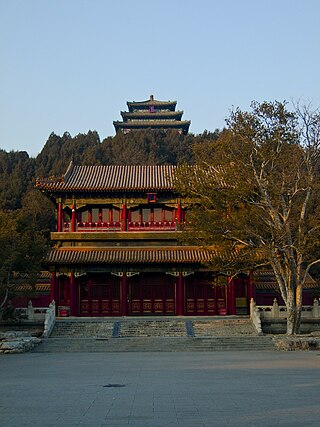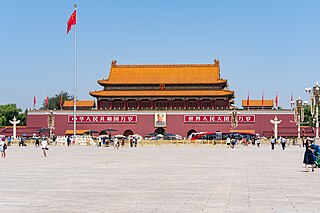
The Forbidden City is the imperial palace complex in the center of the Imperial City in Beijing, China. It was the residence of 24 Ming and Qing dynasty Emperors, and the center of political power in China for over 500 years from 1420 to 1924. The palace is now administered by the Palace Museum. As a UNESCO World Heritage Site, it is one of the most popular tourist attractions in the world. The Forbidden City is arguably the most famous palace in all of Chinese history, and is the largest preserved royal palace complex still standing in the world.

The Tiananmen (also Tian'anmen, or the Gate of Heaven-Sent Peace, is the entrance gate to the Forbidden City palace complex and Imperial City in the center of Beijing, China. It is widely used as a national symbol.

The Meridian Gate or Wumen is the southern and largest gate of the Forbidden City in Beijing, China. Unlike the other gates of the Forbidden City, the Meridian Gate has two protruding arms on either side, derived from ancient que towers traditionally used to decorate the main entrances of palaces, temples and tombs. The gate has five arches. The three central arches are close together in the main, central section; the two flanking arches are farther apart from the three central arches, and are located between the central section and the protruding arms. The centre arch was formerly reserved for the Emperor alone; the exceptions were the Empress, who could enter it once on the day of her wedding, and the top three scholars of the triennial civil service examinations, who left the exams through the central arch. All other officials and servants had to use the four side arches.

Jingshan Park is an imperial park covering 23 hectares immediately north of the Forbidden City in the Imperial City area of Beijing, China. The focal point is the artificial hill Jingshan. Formerly a private imperial garden attached to the grounds of the Forbidden City, the grounds were opened to the public in 1928. The park was formally established in 1949. It is listed as a Key State Park and is administratively part of Xicheng District in downtown Beijing.

The Gate of Supreme Harmony is the second major gate in the south of the Forbidden City in Beijing, China.

Beijing Central Axis, or Central Axis, refers to a stretch of road in Beijing, China. Beijing Central Axis extends 7.8 kilometers from the Drum and Bell Towers in the north to the Yongdingmen Gate in the south.

Yehe Nara Jingfen, of the Manchu Bordered Yellow Banner Yehe Nara clan, was the wife and empress consort of Zaitian, the Guangxu Emperor. She was empress consort of Qing from 1889 until her husband's death in 1908, after which she was honoured as Empress Dowager Longyu. She was posthumously honoured with the title Empress Xiaodingjing.

The Beijing city fortifications were a series of walls with towers and gates constructed in the city of Beijing, China in the early 1400s until they were partially demolished in 1965 for the construction of the 2nd Ring Road and Line 2 of the Beijing Subway. The original walls were preserved in the southeastern part of the city, just south of the Beijing railway station. The entire perimeter of the Inner and Outer city walls stretched for approximately 60 kilometres (37 mi).

The City Wall of Nanjing was designed by the Hongwu Emperor (1328–1398) after he founded the Ming Dynasty (1368–1644) and established Nanjing as the capital in 1368. To consolidate his sovereignty and defend the city against coastal pirates, he adopted the suggestions of advisor Zhu Sheng to build a higher city wall, to expand strategic food reserve and to postpone the coronation. The construction of the wall required the labor of 200,000 workers over twenty-one years to complete. Around 7 million cubic metres of earth were shifted. The City Wall of Nanjing was among the largest city walls ever constructed in China. The enclosed Nanjing City is about 55 square kilometers.

Qianmen is the colloquial name for Zhengyangmen, a gate in Beijing's historic city wall. The gate is situated to the south of Tiananmen Square and once guarded the southern entry into the Inner City. Although much of Beijing's city walls were demolished, Zhengyangmen remains an important geographical marker of the city. The city's central north–south axis passes through Zhengyangmen's main gate. It was formerly named Lizhengmen.

The Imperial City is a section of the city of Beijing in the Ming and Qing dynasties, with the Forbidden City at its center. It refers to the collection of gardens, shrines, and other service areas between the Forbidden City and the Inner City of ancient Beijing. The Imperial City was surrounded by a wall and accessed through seven gates and it includes historical places such as the Forbidden City, Tiananmen, Zhongnanhai, Beihai Park, Zhongshan Park, Jingshan, Imperial Ancestral Temple, and Xiancantan.

The Battle of Peking, or historically the Relief of Peking, was the battle fought on 14–15 August 1900 in Beijing, in which the Eight-Nation Alliance relieved the siege of the Peking Legation Quarter during the Boxer Rebellion. From 20 June 1900, Boxers and Imperial Chinese Army troops had besieged foreign diplomats, citizens and soldiers within the legations of Austria-Hungary, Belgium, Britain, France, Italy, Germany, Japan, Netherlands, Russia, Spain and the United States.

The Imperial City is a walled enclosure within the citadel of the city of Huế, the former imperial capital of Vietnam during the Nguyễn dynasty. It contains the palaces that housed the imperial family, as well as shrines, gardens, and villas for mandarins. Constructed in 1803 under Emperor Gia Long as a new capital, it mostly served a ceremonial function during the French colonial period. After the end of the monarchy in 1945, it suffered heavy damage and neglect during the Indochina Wars through the 1980s. The Imperial City was designated as a UNESCO World Heritage Site in 1993 and is undergoing restoration.

The Ming Palace, also known as the "Forbidden City of Nanjing", was the 14th-century imperial palace of the early Ming dynasty, when Nanjing was the capital of China.

Zhaoling, also known as Beiling is the tomb of the first Qing emperor, Hong Taiji, and his Empress Xiaoduanwen.

Tiananmen Square or Tian'anmen Square is a city square in the city center of Beijing, China, named after the eponymous Tiananmen located to its north, which separates it from the Forbidden City. The square contains the Monument to the People's Heroes, the Great Hall of the People, the National Museum of China, and the Mausoleum of Mao Zedong. Mao Zedong proclaimed the founding of the People's Republic of China in the square on October 1, 1949; the anniversary of this event is still observed there. The size of Tiananmen Square is 765 x 282 meters. It has great cultural significance as it was the site of several important events in Chinese history.

The Hall of Mental Cultivation is a building in the inner courtyard of the Forbidden City in Beijing, China. The hall is a wooden structure with dome coffered ceilings, and was first built during the Ming dynasty in 1537, and was reconstructed during the Qing dynasty. During the early Qing dynasty under the reign of the Kangxi Emperor the hall was mostly used as a workshop, wherein artisan objects like clocks were designed and manufactured. From the reign of the Yongzheng Emperor during the 18th century, the hall was the residence for the emperor. Under the reign of the Qianlong Emperor until the fall of the Qing dynasty, the hall became the centre of governance and political administration. In the Western Warmth Chamber, the emperor would hold private meetings, and discuss state affairs with his mandarins. After the death of Emperor Xianfeng, from inside the Eastern Warmth Chamber, empress dowagers Ci'an and Cixi would hold audiences with ministers and rule from behind a silk screen curtain during their regencies for emperors Tongzhi and Guangxu, who both succeeded to the throne as children in the second half of the 19th century.

The Imperial Citadel of Thăng Long is a complex of historic buildings associated with the history of Vietnam located in the centre of Hanoi, Vietnam. Its construction began in 1010 and was completed in early 1011 under the reign of Emperor Lý Thái Tổ of the Lý dynasty.

Di'anmen, previously Bei'anmen, was an imperial gate in Beijing, China. The gate was first built in the Yongle period of the Ming dynasty, and served as the main northern gate to the Imperial City. The gate was located north of Jingshan Park and south of the Drum Tower. The gate was demolished in 1954. Efforts to restore it have been under way since 2013.

The Gate of Heavenly Purity is the main gate of the Inner Court of the Forbidden City, in Beijing, China. The gate once led people to Forbidden City's residential quarters. It is connected to the Palace of Heavenly Purity, and near the Gate of Thriving Imperial Clan.




















